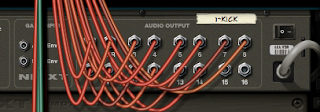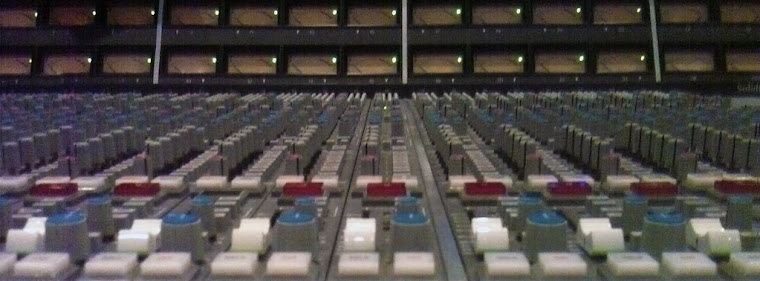Here's the link - http://www.megaupload.com/?d=3R910PSN
(if you download it, there are some useful notes at the bottom of the post)
I made more videos this time explaining it, but I still wanted to write a little.
So in Part 4, I messed with Logic and made a fake trash mic. After that, I had to pull all the samples into Reason. I already had a template made, so I could just bring in the samples and not have to worry about too much routing.
Pulled them into the NN-XT's. There was one
NN-XT for each drum. Each NN-XT contained samples from 14 mics, with clips of the drum being hit at different velocities.
 I had to sort them by velocity and set up the velocities so that it sounded like the drums got naturally louder when the keys are pressed harder.
I had to sort them by velocity and set up the velocities so that it sounded like the drums got naturally louder when the keys are pressed harder. So after that, I assigned each sample to an output according to which mic it was recorded with. There are several samples going to the same outputs, but each output only receives signal from one mic.
So after that, I assigned each sample to an output according to which mic it was recorded with. There are several samples going to the same outputs, but each output only receives signal from one mic. I used a total of 14 outputs on each NN-XT. Each output was then routed to a mixer which represented it's corresponding microphone. Each mixer had 11 channels of audio (2 of them being stereo). So, for instance, the mixer that represents the mic that was used to record the inner kick (D 112) receives all the signals from each NN-XT that was recorded with the D 112, regardless of which drum it is.
So from there, on each mixer, I had to take everything other than primary drum that was being recorded with that mic, and I had to send it out aux 4 (pre) and subgroup it all into one channel. This made it easier to add some controls to the combinators (you'll see).
Then I used aux 1 to send everything to some effects. It's all going to some distortion units. I know that shouldn't be done with a parallel connection, but this distortion really fucks up the drums, and it sounded better to have some dry signal mixed in as well.
I also took the main output of each mixer and ran it through some distortion to simulate tubes and tape. For all these effects, each mixer had to have it's own FX unit. Otherwise, everything would have needed to be grouped to a stereo mix to go through the tape units, and it would have only come back in one stereo mix for the other distortion units.
 From there, everything goes to some "preamps". Not really preamps... just mixers that come before another mixer (whether it be in Reason or in another DAW). It's still useful to have them though. They probably wouldn't be useful very often, but it's good to have them incase your signal is too hot (although if it's clipping before the preamps, it should be attenuated before the preamps).
From there, everything goes to some "preamps". Not really preamps... just mixers that come before another mixer (whether it be in Reason or in another DAW). It's still useful to have them though. They probably wouldn't be useful very often, but it's good to have them incase your signal is too hot (although if it's clipping before the preamps, it should be attenuated before the preamps). I also had to do some shit within the combinators to make the knobs and button in it control shit on the devices within each combinator... but I won't even talk about that.
---------------------------------------------------------------------------------------------------
VIDEOS
Note: In these videos, I keep hearing pops. I wasn't hearing that during the recording, so I think it was just the screen capture software freaking out.
Also, the drums don't have that clicky sound in them. Every time I play a drum, you hear a click, but that's coming from my keyboard.
And finally, excuse the shitty audio quality. They sound good on my computer, but once uploaded, the quality is horribly reduced.
As I've said in previous posts, this kit in umixed. No EQ, compression, or anything. It's up to the user to make it sound good. I wanted it to be like going into a tracking session and having the kit mic'd and have level set done, but no mixing at all. Thay way, I can start with a clean slate when I go to mix.
Here's a short video with a before and after example.
The "before" is what the drums would sound like during tracking
The "after" is what it sounded like once I did a quick mix.
This drum pattern is cheesey, but it has every single drum being played, so it's good for demonstration I guess.
VIDEOS
Note: In these videos, I keep hearing pops. I wasn't hearing that during the recording, so I think it was just the screen capture software freaking out.
Also, the drums don't have that clicky sound in them. Every time I play a drum, you hear a click, but that's coming from my keyboard.
And finally, excuse the shitty audio quality. They sound good on my computer, but once uploaded, the quality is horribly reduced.
As I've said in previous posts, this kit in umixed. No EQ, compression, or anything. It's up to the user to make it sound good. I wanted it to be like going into a tracking session and having the kit mic'd and have level set done, but no mixing at all. Thay way, I can start with a clean slate when I go to mix.
Here's a short video with a before and after example.
The "before" is what the drums would sound like during tracking
The "after" is what it sounded like once I did a quick mix.
This drum pattern is cheesey, but it has every single drum being played, so it's good for demonstration I guess.
I spend about 30 minutes doing this mix (with headphones), and I think it turned out good. It's definitely way better than what it sounded like at first. So if you download the kit and don't like the way it sounds, then you'll definitely need to do a little mixing.
This one shows a little about how the kit works and how it's layed out.
Here's another video which is pretty much just me elaborating on the first half of this post
Note: When I say the shit about the tracks being grouped to a stereo mix if I'd only used on distortion unit, I meant on the output of that. You'd still have separate channels for each drum, but the FX output would be a stereo mix.
And finally, this one just explains the few problems the kit has.
---------------------------------------------------------------------------------------------------
For anyone who downloads the kit (all two of you), here are some things you'll need to know.
Once downloaded, you'll have an rfl file (refill). It's got a red icon. You'll pull this into your Reason folder. You'll see a couple of other rfl files in there too.
To open the kit, go into Reason and go to Open. Then nagivate to your Reason folder and find the Mantooth Drum Kit refill, then inside that you'll see a folder called "Sessions". Just one one of those 3 sessions.
There are 3 sessions:
Mantooth Drum Kit - use this one when Rewiring Reason to a DAW
Standalone Version - use this if you're just running Reason
Standalone Lite - easier to use, but less control
When you Rewire this to a DAW, you'll need 3 external MIDI channels. One for kick & snare, one for toms, and one for cymbals. Make sure all 3 are armed for record.
When running the standalone, make sure you highlight the track for the combinator you want to play (kick & snare, toms, cymbals). You can only play one combinator at a time. It's not a big deal if you're just writing in MIDI with the pencil tool, but if you're using a keyboard, you may want to use the Standalone Lite version.
Here's the key layout (starts on C3). Obviously, the colors indicate which things are like... related somehow
If you do happen to download the kit and you have any questions, just leave a comment or watch the videos above.
My next post will be bout drum mixing, so if you have a hard time making these sound good, I'll help you out.
This one shows a little about how the kit works and how it's layed out.
Here's another video which is pretty much just me elaborating on the first half of this post
Note: When I say the shit about the tracks being grouped to a stereo mix if I'd only used on distortion unit, I meant on the output of that. You'd still have separate channels for each drum, but the FX output would be a stereo mix.
And finally, this one just explains the few problems the kit has.
---------------------------------------------------------------------------------------------------
For anyone who downloads the kit (all two of you), here are some things you'll need to know.
Once downloaded, you'll have an rfl file (refill). It's got a red icon. You'll pull this into your Reason folder. You'll see a couple of other rfl files in there too.
To open the kit, go into Reason and go to Open. Then nagivate to your Reason folder and find the Mantooth Drum Kit refill, then inside that you'll see a folder called "Sessions". Just one one of those 3 sessions.
There are 3 sessions:
Mantooth Drum Kit - use this one when Rewiring Reason to a DAW
Standalone Version - use this if you're just running Reason
Standalone Lite - easier to use, but less control
When you Rewire this to a DAW, you'll need 3 external MIDI channels. One for kick & snare, one for toms, and one for cymbals. Make sure all 3 are armed for record.
When running the standalone, make sure you highlight the track for the combinator you want to play (kick & snare, toms, cymbals). You can only play one combinator at a time. It's not a big deal if you're just writing in MIDI with the pencil tool, but if you're using a keyboard, you may want to use the Standalone Lite version.
Here's the key layout (starts on C3). Obviously, the colors indicate which things are like... related somehow
If you do happen to download the kit and you have any questions, just leave a comment or watch the videos above.
My next post will be bout drum mixing, so if you have a hard time making these sound good, I'll help you out.






























